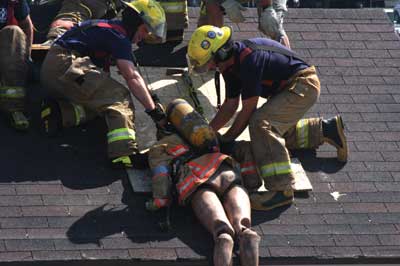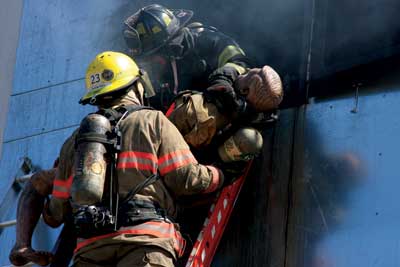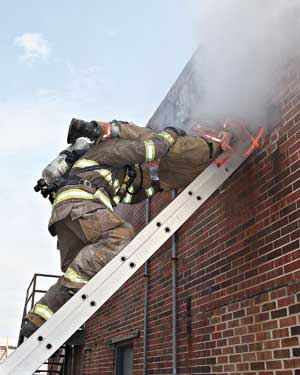BY MIKE MASON
By now, departments throughout the United States should be familiar with the need for rapid intervention and the extreme importance of its presence on the fireground. The relationship among rapid intervention policies; rapid intervention crews (RICs); rapid intervention training; and officers, RIC leaders, and chief officers can be overwhelming as can be meeting the standards of National Fire Protection Association (NFPA) 1407, Standard for Training Fire Service Rapid Intervention Crews. It is also necessary to correlate NFPA 1407 with other important standards that mention the need for rapid intervention.
 |
| (1-4) Firefighters perform firefighter rescue and survival techniques during training. (Photos courtesy of RICOFIRERESCUEINC.) |
RICs and firefighter survival go hand in hand especially when training and preparing a solid rapid intervention presence on the fireground. A fire chief or incident commander’s worst nightmare at structural fires is a Mayday. Just gaining control of such an incident can be daunting for some departments, as can be establishing the presence of a RIC at their structural fires. To survive the fireground, a rapid intervention presence cannot be questioned and should be provided for no matter what size team you can muster. Proactive training well before an incident occurs is needed in three prominent areas: firefighter self-survival, firefighter rescue, and firefighter RIC coordination.
All three areas require specific techniques and maneuvers that range from an individual firefighter’s actions to the actions of the RIC, RIC leaders, and chief officers. Departments should have a well-written training program and policies that contain proactive as well as reactive action plans. As we know, even the best training and written policies can never predict the event itself or what it may entail in saving one of our own.

Although standards like NFPA 1407 provide insight for qualified personnel that enables them to perform such rescues and the techniques and maneuvers, these procedures are not identified in the document. The standard requires that every department have a standard operating guideline (SOG) that includes the presence of a RIC at all fireground operations, deploy a RIC at incidents, and ensure that the RIC is trained to develop an action plan from the beginning of an incident through its termination.
NFPA 1407 establishes many guidelines that departments can use as a base for successfully mitigating these incidents as well as provides some proactive behaviors that will help to prevent these emergencies. Departments need to start with a sound and comprehensive training program that includes objectives and hands-on skills that may be needed for situations involving firefighters in distress and their rescues. These skills should be practiced in near-zero visibility environments. Firefighters of all ranks, including chiefs, should understand rapid intervention and all that it entails.
NFPA 1407, in conjunction with NFPA 1500, Standard on Fire Department Occupational Safety and Health Program; NFPA 1710, Standard for the Organization and Deployment of Fire Suppression Operations, Emergency Medical Operations, and Special Operations to the Public by Career Fire Departments; NFPA 1720, Standard for the Organization and Deployment of Fire Suppression Operations, Emergency Medical Operations and Special Operations to the Public by Volunteer Fire Departments; NFPA 1401, Recommended Practice for Fire Service Training Reports and Records; and NFPA 1561, Standard on Emergency Services Incident Management System and Command Safety, provide guidelines for qualifying instructors, RIC team sizes, and criteria for team leaders.

There are only a handful of training programs and qualified instructors throughout the United States who have thousands of hours of instructing in rapid intervention and all it entails. These instructors and their programs exceed NFPA 1407 requirements. Nonetheless, departments should make every effort to meet the minimums by attending these programs and bringing the information back to their departments so they can establish a well-prepared rapid intervention program and a sound command and control presence for their chief officers. The training programs should cover risk assessment, deployment and activation of RICs, radio communications procedures, the integration of firefighter Maydays and their rescues into departmental incident command systems, and full and operable accountability systems.
Rapid intervention techniques and maneuvers also necessitate a vast knowledge of tools and equipment and their applications. A well-trained and well-equipped RIC with just the basics in equipment is a safety net at structural fires, but the crew must be knowledgeable in technical rescue skills as well. Each Mayday scenario has the potential for “the unexpected.”
Chief officers also must understand their, as well as the RIC’s, capabilities to deal with the expected and the unexpected associated with the chaotic and complex challenges presented in firefighter rescues. Getting control of and mitigating such incidents take nerves of steel, resources, and the ability to evaluate dynamic risk to all on the fireground.

Mayday and the Survivability Profile
When rapid intervention operations become necessary for a Mayday, the department’s resources, communication systems, and training are challenged. Anything can occur at any time on the fireground, especially when offensive interior firefights are involved. The survivability profile of a Mayday necessitates action plans that have been trained on. All fires, as we know, progress in different ways in a fast-paced dynamic environment, which can lead to events ranging from simple disorientation to a structural collapse that entraps firefighters. These events can affect also the RIC members. Thus, adequate resources and staffing must be on the scene at any given firefight, offensive or defensive.
The important issue for survivability of the individual firefighter is the sending of a Mayday communication as soon as the firefighter perceives or realizes that something has gone wrong. If physically able, the firefighter should also attempt survival techniques while command and the RIC are attempting to mitigate the situation. Firefighters need to pay strict attention to the many fireground activities going on at any given incident within their immediate area and by digesting important radio communications regarding efforts in fire extinguishment, ventilation, life rescue, and personal accountability reports.
Firefighter training requires us to solve problems individually and as a team. It also represents a double-edged sword: The need to rectify and beat the problem you are facing may make you determined to succeed first and delay your calling a Mayday. Get your Mayday message out first, and then try to resolve the issue. If you succeed, you can call off or withdraw the Mayday.
Incorporate the NFPA 1407 guidelines for communicating a Mayday into your training programs and policies. Firefighters having a distress event are to communicate a Mayday within 30 to 60 seconds if they are able to. Firefighters should issue a Mayday also when witnessing other events within their proximity such as a partial collapse, a flashover, and an unconscious firefighter.
NFPA 1407 does not provide a mnemonic or acronym to help distressed firefighters organize their thoughts when under distress to provide adequate and proper information when communicating their Maydays. Firefighters in distress commonly use the two below for communicating a Mayday. Although these mnemonics are fairly simple to remember, you must practice them into memory.
LUNAR
Location. Where are you geographically within the structure or event?
Unit. What company are you/were you with?
Name. Communicate your last name, not your fire number.
Assignment and Air supply.
Resources. What is needed to help with and rectify the problem? What are you doing to rectify the problem?
LIP
Location. Where are you geographically within the structure or event?
Identification. Include your last name, your company, and your assignment.
Problem. Include resources to assist and rectify the problem, your air supply, and what you may be doing to rectify the problem.
In addition to self-survival skills, rescue skills, and coordinated RIC skills, the training program should cover the use of ropes, knots, and webbing; mechanical advantage systems; air supply systems and maneuvers for providing air to distressed firefighters; rapid and accountable search rope techniques; multiradio channel skills and techniques for RIC and chief officer communications; thermal imaging; and forcible entry/ingress and egress.
It is impossible for a RIC to carry all the potential tools and equipment that may be needed at structural fire emergencies. One solution for this situation is to divide equipment into two categories: primary equipment, which must be present immediately in case a deployment is needed early in the event, and secondary equipment, which can be acquired from nearby fire apparatus on the scene. The RIC should have the primary equipment when it arrives to establish a rapid intervention presence at the structure and preferably at or near the point of offensive procedures such as a hoseline entering a front door or in the area of a vent-enter-search procedure after it has completed its 360° size-up. This type of proactive positioning should be established when the RIC is sizing up the structure and learning where interior crews are functioning. RIC primary tools would include the halligan and ax, RIC air supply, the New York hook, a utility rope bag (150 feet and two large carabiners), a search rope bag (150 feet of 9-mm rope), a thermal imaging camera, personal looped webbing (16 feet and short quick-grab strap), wire cutters, flashlights, and portable radios.
Secondary tools and equipment, which can be acquired from nearby fire apparatus, include the following: roof, extension, and attic ladders; rotary saw wood/metal blade; spare self-contained breathing apparatus and additional RIC air supply; an additional hoseline, pulled and charged; additional battery-operated equipment (reciprocating saw, cutters, and spreaders); when necessary, cribbing and an air bag system; a stokes basket; and a sledgehammer/maul.
The RIC should size up the activities occurring throughout the fire structure. When retrieving secondary class items, a member should approach the apparatus and advise the operator, if present, that the RIC is requesting the equipment for the rapid intervention needs of the event. The apparatus operator should be instructed through policy and procedures to relinquish the items if the apparatus’ fire crew will not be using them. This helps guarantee that the equipment can be obtained in a timely fashion and the RIC can stage it in its location near the fire structure.
RIC DUTIES
Each incident poses potential threats that can affect interior and exterior operations. The RIC is responsible for identifying and deterring these threats through proactive behavior and constant sizing up of the structure and the fire event. NFPA 1407, although indicating where the RIC should report and stage on the fireground, does not truly indicate what many of their proactive behaviors should entail.
The RIC should be preassigned through dispatch within the first alarm. A well-trained RIC, with a well-connected team leader and possibly a RIC commander or RIC chief, should provide the following proactive activities on the fireground:
- Provide confirmation en route and on arrival.
- Stage at the point of any offensive procedures that reveal members operating on the interior.
- Perform a complete 360° size-up when possible.
- Communicate to interior members and to chief officers any potential threats involving the firefight.
- Provide all proactive hands-on tasks as needed to guarantee the safety of all members working on the interior and members involved in roof operations, which include but are not limited to providing ingress and egress of the structure without affecting fire conditions unless necessary; assisting other companies on the exterior as needed while still maintaining RIC functions; laddering the structure where needed; positioning additional hoselines for potential rescue operations; removing barriers such as burglar bars, blocked exits, and gates; enlarging openings when necessary without disturbing fire conditions when needed; providing all radio communications on all tasks being performed and completed; and provide full radio communications and monitoring of interior crews and all crews functioning on the fireground throughout the duration of the incident or until so relieved.
A well-trained and functioning RIC on the fireground is invaluable! Its responsibilities are a serious business. RICs provide not only protection and rescues of firefighters, but they also enhance the safety of the fireground tenfold. They provide commanders and chief officers with complete support in all fireground activities that may have potential for disaster well before the potential threat of a Mayday may develop. Solid and complete policy and procedures along with the use and review of NFPA 1407 will ensure the protection of our members and the prevention of potential tragedies.
MIKE MASON is a 28-year veteran of the fire service and a lieutenant with the Downer’s Grove (IL) Fire Department, assigned to Truck 1/Squad 1. He is a certified instructor III and fire officer II. He has an associate degree in fire science and master’s certificates in strategic and organizational leadership from several universities. He is a senior staff instructor as well as the director and founder of the not-for-profit RICOFIRERESCUE INC. He also instructs for the New York State Association of Fire Chiefs, the Downers Grove Fire Academy, the Chicago Fire Academy, the Romeoville Fire Academy, and John Wood Community College.
Mike Mason will present “Surviving the Battleground in Structural Firefighting” on Friday, April 11, 10:30 a.m.-12:15 p.m. at FDIC 2014 in Indianapolis.
Fire Engineering Archives

